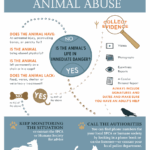In an age where our society champions progress and innovation, it is perplexing that a topic so fundamental to our moral compass—animal cruelty—continues to exist in a gray area of legal enforcement across various states. Much like a patchwork quilt, the laws governing animal welfare in the United States are disparate, with each state sewing its own image into a larger narrative. Yet, as the pieces vary in color and texture, the question remains: why isn’t animal cruelty unequivocally designated as a felony in every state?
The significance of understanding this issue is akin to peering into a kaleidoscope; what initially appears to be an array of beautiful patterns can quickly reveal fractures and discord when looked at more closely. The complex tapestry of animal rights laws varies widely, driven by a confluence of cultural, economic, and legislative factors. In some states, the penalties for animal cruelty are as lenient as a gentle breeze, while others impose stringent repercussions that reflect a staunch commitment to animal rights. This variability breeds confusion and, more importantly, showcases inconsistencies in how societies value life.
The foundation of many state laws can be traced back to historical perceptions of animals. For centuries, animals were often regarded merely as property—objects devoid of inherent rights. In this antiquated view, their suffering was trivialized, as they were seen through a lens akin to that of a broken fence post rather than a sentient creature deserving of compassion. Although times have changed, the echoes of this mindset still resonate in some of today’s legal frameworks, underpinning inadequate penalties for acts of cruelty.
Moreover, the legislative approach to animal welfare is frequently influenced by regional culture. States with rural economies might prioritize agricultural traditions that sometimes conflict with animal rights. The agricultural paradigm often paints a narrative where the economic utility of animals overshadows their sentient existence. Thus, states with a strong agrarian influence may hesitate to impose felony-level penalties on actions that, while cruel, are rooted in longstanding practices. It is a delicate dance, one that balances tradition against evolving ethics, often leaving animals caught in the fray.
This disparity intensifies when considering the emotional and psychological ramifications of animal cruelty. A dog bound in a dilapidated yard may evoke pity, yet the same sentiment often doesn’t extend to farm animals whose lives are consumed by profit. This inconsistency suggests that societal empathy is selective, determined by the species or circumstance rather than a universal moral principle. Animal cruelty, then, becomes a subjective line drawn in shifting sand.
The legal landscape is not merely anecdotal; statistical data reveals stark differences in conviction rates and penalties. In states where animal cruelty is a misdemeanor, offenders are often met with a mere slap on the wrist; fines may be accompanied by short sentences, if any punishment is administered at all. Conversely, states where animal cruelty is treated as a felony demonstrate a far greater commitment both to legal enforcement and societal education regarding the issue. The ramifications of this uneven legal treatment extend beyond the courtroom, impacting public perceptions and influencing the importance of humane education in the community.
Education emerges as a critical player in the realm of animal welfare. Changing the laws requires changing mindsets. As such, advocacy and awareness campaigns become vital avenues for galvanizing public support for more rigorous animal protections. These initiatives aim to illuminate the intrinsic value of animals and challenge the entrenched beliefs that foster cruelty. Educational outreach can serve as the catalyst for change, inspiring a movement toward unified legal standards and ethically informed practices.
This change is not unprecedented. Just as movements for social justice have reshaped the moral fabric of society, the push for comprehensive animal rights legislation has the potential to evolve in similar ways. Recent history showcases a rising trend, with both grassroots organizations and high-profile advocates rallying behind the cause. The incremental victories are akin to the slow but steady erosion of a mountain face, shaped ultimately by persistence and time.
For animal cruelty to be codified as a felony across all states, a shift in the national consciousness is essential. A proposal for federal oversight—including a comprehensive framework for the prosecution of animal cruelty—could serve as the cohesive thread that binds the quilt. This shift could standardize how we perceive the value of all sentient beings, demanding a substantial reevaluation of both legal practices and societal norms.
Ultimately, the battle against animal cruelty is not simply a legal fight; it is a moral one. It calls for individuals to grapple with uncomfortable truths and challenge prevailing attitudes. The question persists: will society rise en masse to declare that cruelty—irretrievably and unequivocally—is a transgression that cannot be tolerated, that deserves to be met with the full weight of the law? When we begin to appreciate the fragility of life, extending our empathy beyond pet ownership to encompass all animals, only then may we witness transformative legal advancements in the quest for justice.
In conclusion, understanding the reasons why animal cruelty is not a felony in every state reveals larger questions about ethics and the value of life itself. As society grapples with its own moral evolution, it is crucial to advocate for consistency and compassion, urging lawmakers to turn the tide in favor of safeguarding the innocent. As we advocate for the voiceless, every call for justice brings us closer to an ethical paradigm where animal cruelty is unequivocally condemned across the entire nation.






